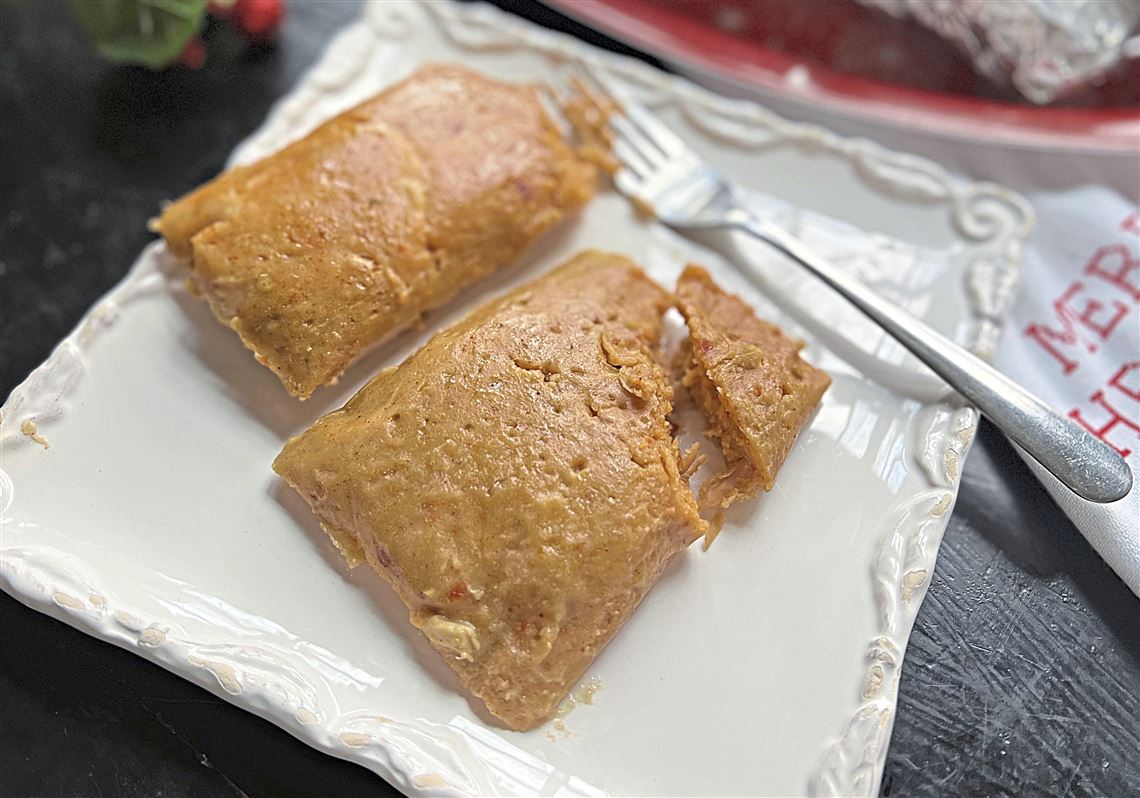Andrea Peraza likes to make tamales with her mother, Sonia, especially when each handles certain tasks.
“I don’t like the prep. That’s my mom’s part,” she says, laughing.
When the Perazas make a batch of tamales, Andrea is in charge of placing the filling in the center of the banana leaves, then folding each into a tidy little package. Her mother doesn’t like the assembly part of the process, so it works out well for the Salvadoran family who moved to Pittsburgh six years ago.
Salvadoran tamales are different from Mexican tamales in that they’re made with seasoned masa that’s steamed inside of banana leaves instead of corn husks. They’re also not as spicy — the spice mix used to flavor them, relajo, is warm rather than hot — and they often contain garbanzo beans or potatoes, unlike their northern cousins. Another key difference: The masa is cooked before being placed into the leafy containers.
“They’re called tamales colados,” says Marcella Ogrodnik, chef-owner of Cafe Agnes, which sells Salvadoran tamales and pupusas at area farmers markets.
The masa is combined with broth and fat (lard, butter or oil), then boiled until it has a sticky consistency.
“Tamales colados have more of a pudding-like texture, with a much softer masa texture, than the Mexican style, where it’s a little more dry and cakey,” she says.
The banana leaf also adds a nice floral aromatic.
The Perazas’ tamale recipe was born of necessity in many ways. In El Salvador, Andrea notes, tamales are easy to find. With a dearth of options here, mother and daughter devised their own recipe based on what they did in their home country and videos they found on YouTube.
Andrea, a college student, says she, her mom and other family members and friends tend to make tamales for special occasions, with “different tamales for almost every season.” To celebrate Dia de los Muertos, she notes, the filling includes pork. Easter week is meat-free, with beans, and chicken is traditional around Christmastime.
The Perazas will be churning out tamales de pollo for New Year’s Day, holding a tamalada, or tamale-making party, with relatives visiting from New York.
Salvadoran Chicken Tamales
PG tested
You can find frozen banana leaves at Mexican groceries such as Las Palmas in Brookline or Los Campos in Wexford; Asian markets including Lotus Food in the Strip District have them as well. (They’re also readily available on Amazon.) Be careful when you rinse and dry them; they’re fragile.
For the best taste? Don’t freeze them: “We normally eat them fresh,” Andrea says.
For filling
2 pounds boneless chicken thigh or breast, or combination
Several sprigs fresh cilantro
1 onion, rough chopped
4 bay leaves
2-3 heads garlic, peeled and separated
32 ounces chicken stock
2½ pounds dried masa (Maseca brand)
2 cups water
1 pound pork lard
2 tablespoons oil
2 tablespoons salt
For sauce
10 plum tomatoes, chopped
1 onion, peeled and diced
2 green bell peppers, coarsely chopped
2 4-ounce bags relajo spice mix
For tamales
3-5 dozen banana leaf squares, thawed if frozen, and gently wiped clean
3-5 dozen foil squares, approximately 10 by 12 inches, for wrapping
Prepare chicken: Place chicken, cilantro, chopped onion, bay leaves and garlic in a large pot. Cover with enough chicken stock to cover by 2 inches (if 32 ounces is not enough, add water). Bring to a boil over high heat, then reduce to a simmer.
Simmer for 20-25 minutes, adding more stock or water as needed so the chicken remains submerged. Strain the cooked chicken, reserving the liquid, and set aside until cool enough to handle. (It’s OK if the meat isn’t fully cooked through, as it will continue to cook when steamed later.) When cool, shred into bite-sized pieces.
Make sauce: In large bowl, toss diced tomatoes with diced onions and peppers and relajo. Add 2 cups of water, then blend using an immersion blender. (Optional: For a deeper flavor, roast the veggies and spice mix before you add the water and blend.) Strain and set aside (or blend in a food processor).
Prepare banana leaves: Trim any tough stem from leaves and gently wipe off any dirt. If frozen, they will thaw in about an hour on the counter. Run the leaves under very hot water to soften.
Make filling: Combine dried masa with 2 cups water, lard, 2 tablespoons oil, 2 tablespoons salt and 8 cups of reserved chicken broth in a large pot or Dutch oven. Whisk together until you have a mixture that is smooth with the consistency of ketchup.
Bring masa mixture to a boil over medium-high heat, stirring constantly with a wooden spoon. Slowly add in the sauce, and continue whisking while you boil the mixture, uncovered, until thick and sticky, about 5 minutes.
Add shredded chicken to the masa mixture.
Fill a steamer pot to the fill line. Bring to a boil while you assemble tamales. Place a layer of banana leaves on the bottom of the steamer basket.
Set up your assembly line for making tamales, with softened banana leaves and foil squares.
Place a leaf on top of a foil square, then, in the middle of each leaf, add about 4 tablespoons of the cooked masa mixture. Fold each leaf burrito style — bottom first, then each side, then the top, into a rectangle with the filling sealed inside. You don’t want any air pockets. Wrap foil sheets around each, sealing well.
Place the tamale packets into the steamer basket and top with a final layer of leaves. Steam over medium heat for about two hours. You may have to add water from time to time to keep it steaming. Tamales are done when the banana leaf pulls away cleanly from the tamale and the masa holds its shape.
Remove from pan, and cool before serving.
Makes 40-50 tamales.
— Sonia and Andrea Peraza
Polly Higgins: phiggins@post-gazette.com, 412-263-1960, Twitter @higginspolly, IG @pollyhig.
Gretchen McKay: gmckay@post-gazette.com, 412-263-1419 or on Twitter @gtmckay or IG @pgrecipes.
First Published: December 17, 2021, 5:00 a.m.
Updated: December 17, 2021, 3:21 p.m.



















